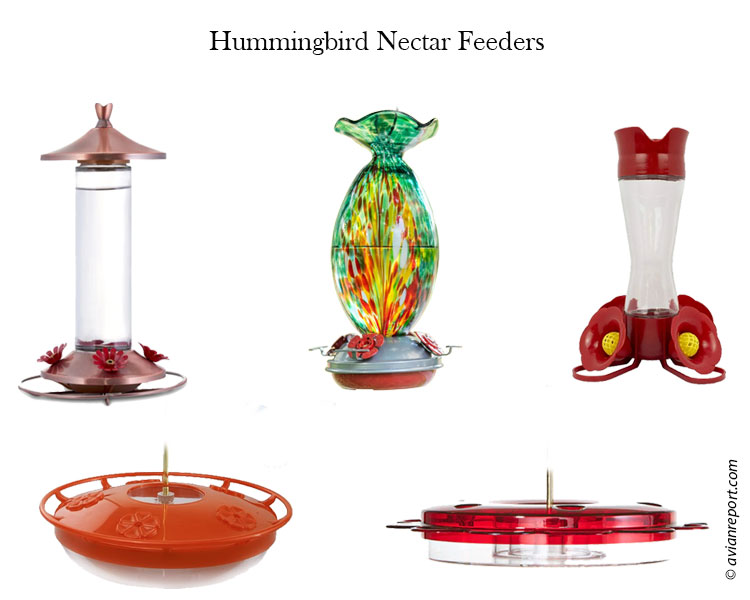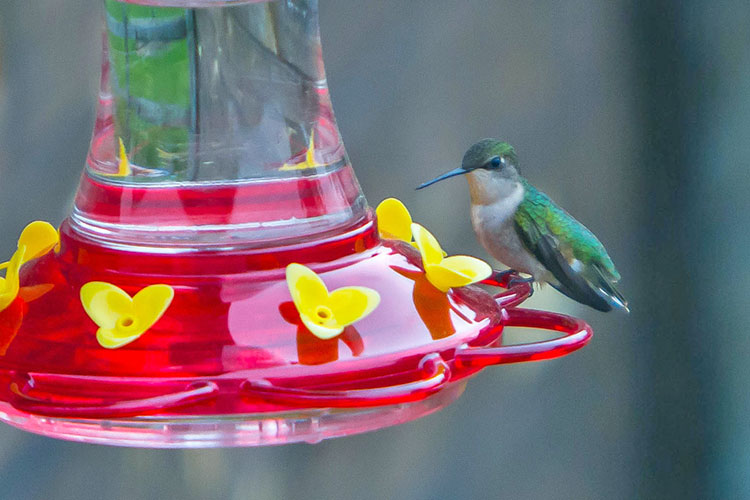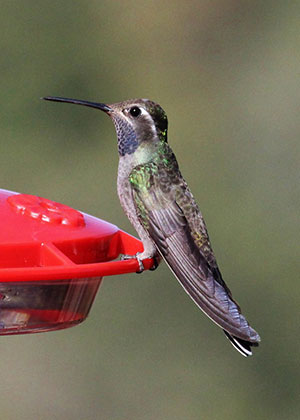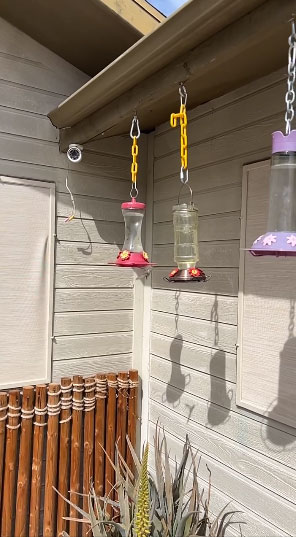How can I attract hummingbirds to my backyard? The answer is simple: hummingbird nectar feeders! These small, red feeders dispense sugar water, the perfect fuel for these high-energy birds. Read on to learn how nectar feeders work, where to place one for optimal use, and how to maintain them to keep hummingbirds coming back for more. Don’t worry, we’ll also cover the best time to take down your feeders.

What is a hummingbird nectar feeder?
Hummingbird nectar feeders are specialized feeders designed to attract hummingbirds by offering a substitute for their natural food source – flower nectar. Hummingbird nectar feeders offer a delightful way to observe these dazzling birds in your yard.
How does a hummingbird nectar feeder work?
Before we go on to how this type of feeder works I’ll cover the key parts.
- Design: These feeders are typically made of brightly colored plastic, generally red, and come in various shapes and sizes.
- Nectar Reservoir: The feeder has a reservoir that holds a sugar-water solution, mimicking flower nectar.
- Feeding Ports: The feeder has one or more small feeding ports with flower-like appendages. Some feeder have perches where hummingbirds can land comfortably to drink. Others do not have perches and hummingbirds hover over the port mimicking the natural way hummingbirds feed over flowers.
- Leak-proof Design: Nectar feeders are designed to prevent leaks and spills that can attract unwanted insects or create a mess.
Related:
Fruit & Jelly Bird Feeders
Window Bird Feeders
Suet Bird Feeders

Mechanics of Nectar Supply:
The nectar reservoir dispenses the sugar-water solution through the feeding ports. Some feeders may have a built-in mechanism that allows the nectar to fill the feeding ports as the sugar water level in the reservoir decreases. This mechanism ensures the ports are always full and nectar accessible to the hummingbirds.
Addition details
Hummingbird nectar feeders can be a great way to attract hummingbirds to your yard, but here are a few things to consider:
- Nectar Recipe: It’s important to use the right sugar-water ratio (typically 1 part sugar to 4 parts water) to avoid harming the hummingbirds. Store-bought nectar mixes are also available.
- Cleaning: Regular cleaning of the feeder is crucial to prevent the growth of mold or bacteria that can harm the hummingbirds.
- Species Specificity: North American hummingbirds have relatively straight beaks and will readily use feeders.

The design and placement of the feeder can influence which species visit and the frequency of visits. For example, some hummingbirds feeders have perches and others don’t. As a general rule, larger species tend to cling to flowers while obtaining nectar. Larger hummingbirds favor feeders with perches.
Smaller species hover the entire time. These hummingbirds do well at feeders with and without perches.
One thing to remember is to use the right nectar solution, clean the feeders regularly, and consider the feeder design to attract the species of hummingbirds you’d like to see.
Related:
Globe Bird Feeders
Thistle Bird Feeders
Hopper or House Bird Feeders
Description of hummingbird Feeders:
- Material: Hummingbird feeders are typically made of plastic that is lightweight and shatter-resistant. Some feeders may have glass reservoirs.
- Design: These feeders come in a variety of shapes and sizes, but most have a red colored reservoir to attract hummingbirds as red is a color they associate with nectar. The feeder has a base that holds the nectar solution and a feeder head with flower-shaped feeding ports.
- Features: The feeder head has multiple feeding ports equipped with or without perches to allow hummingbirds to perch or hover comfortably while feeding.
Some feeders have built-in ant moats to deter ants from reaching the nectar solution. Most feeders are designed to be leak-proof and easy to disassemble for cleaning. - Size and Variety: Hummingbird feeders come in a variety of sizes, ranging from small feeders holding just a few ounces of nectar solution to larger feeders that hold up to a quart.
Nectar formula:
- A mixture of one part sugar to four parts water is the recommended recipe for hummingbird nectar.
Nectar Capacity :
- Nectar capacity varies depending on the size of the feeder, but typically ranges from 4 ounces to 32 ounces of nectar solution.
Refilling Recommendation:
- To ensure fresh nectar and prevent spoilage, it’s recommended to refill your hummingbird feeder every few days, especially during hot weather.
Monitor the nectar level regularly and clean the feeder thoroughly every time you refill it.
Birds Attracted:
- Hummingbird feeders primarily attract hummingbirds, with the exact species depending on your location.
Some common visitors in North America include:- Ruby-throated Hummingbird
- Black-chinned Hummingbird
- Anna’s Hummingbird
Advantages:
- Attracts beautiful hummingbirds to your backyard, adding color and movement.
- Clear reservoir allows for easy monitoring of nectar levels.
- Multiple feeding ports allow several hummingbirds to feed at once.
- Many feeders are designed to be easy to clean and leak-proof.
Disadvantages:
- Requires regular refilling and cleaning to maintain fresh nectar and prevent mold growth.
- May attract insects like bees, ants, and wasps, requiring monitoring.
- Not suitable for attracting other bird species.
Where to Place Your Hummingbird Feeder

Once you have your new hummingbird feeder and are eager to set it up the question that comes to mind is where to hang it? Picking the ideal location is key to attracting hummingbirds and ensuring they feel safe and comfortable while feeding.
Here are a few tips to finding the perfect place for your feeder:
Dos:
- Near Flowers: Hang your feeder close to flowering plants, especially native varieties that attract hummingbirds. This creates a natural food source alongside the sugar water you provide.
Native flowers will also help hummingbirds find your feeder. Hummingbirds have the uncanny ability to detect colors as they dazzle through the landscape. Instinctively, they drop to investigate a flower of colors associated with nectar. Once they find your flowers they will find the adjacent feeder. - Partial Shade: Hummingbirds expend a lot of energy hovering. Aim for an area with dappled sunlight or afternoon shade. Direct sun can heat up the feeder and spoil the nectar in a shorter period of time.
- Protected from the Elements: Windy areas can make it difficult for hummingbirds to feed. Choose a sheltered location, but avoid placing it right next to walls or fences where predators might lurk.
- Easy Viewing for You: While hummingbirds are the stars of the show, you’ll want to enjoy watching them too! Hang the feeder near a window, porch, or patio where you can easily observe their dazzling colors.
- Within Arm’s Reach: Pick a spot that allows you to conveniently refill and clean your feeder.
Don’ts:
- Direct Sunlight: Avoid hanging the feeder in full sun, as this can overheat the nectar and discourage hummingbirds.
- Open Areas: Don’t place the feeder in an exposed location with strong winds.
- Too Close to Windows: While you want a good view, feeders too close to windows can be a hazard for hummingbirds as they may collide with reflecting glass. Maintain a safe distance to prevent collisions.
- Near Bird Feeders: Large bird feeders can intimidate hummingbirds. Keep them separate to avoid competition and stress for the hummingbirds.
- Forget Maintenance: Hummingbird feeders need regular cleaning and refilling with fresh nectar to prevent mold growth and attract healthy birds.
Should I Take Down My Hummingbird Feeder in the Fall?
These nectar feeders will attract numerous hummingbirds for only a few weeks during migration. After that period, they all move on, regardless of the presence of the feeders.
A frequently asked question is whether having hummingbird feeders through the Fall will disrupt hummingbird migration patterns.
As summer fades and fall approaches, you might wonder if it’s time to pack away your hummingbird feeder. After all, these tiny birds seem to disappear overnight. The truth is, hummingbirds have an internal compass and an instinct for migration. More than anything else, the gradual change in daylight and temperature trigger the initiation of migration.
Regardless of whether feeders are available, they will embark on their southward journey when day length shortens and food sources dwindle.
So, does keeping your feeder up late in the fall disrupt this natural behavior? The answer is no! Here’s why:
- Hummingbird Migration is Instinctive: Driven by hormones and day length changes, hummingbirds are pre-programmed to migrate south for the winter. The presence or absence of a feeder won’t alter this biological urge.
- Late Feeders Help Stragglers: Not all hummingbirds migrate at the exact same time. Some younger birds or those facing resource scarcity may lag behind. Keeping your feeder up provides a crucial source of energy for these late migrants, giving them the boost they need to complete their long journey.
- Enjoy Hummingbirds for a Little Longer: Let’s face it, hummingbirds are a joy to watch. By maintaining your feeder, you can extend the opportunity to observe them for a few extra weeks as fall advances.
So, fill those feeders with fresh nectar and keep them up a little longer! You’ll be providing valuable sustenance for late departing hummingbirds and enjoying their presence for a bit longer.
Related:
Tube Bird Feeders
Tray (Platform) Bird Feeder
Key Takeaways about Hummingbird Feeders:
- Tiny Bird Treats: Offer a sugar-water solution mimicking flower nectar to attract these dazzling birds.
- Feeder Design: Brightly colored plastic feeders with flower-like feeding ports provide a comfortable spot for them to drink.
- Nectar Reservoir: Holds the sugar-water solution and may automatically refill feeding ports for constant access.
- Right Recipe: Use a 1:4 sugar-to-water ratio or store-bought nectar to avoid harming hummingbirds.
- Cleanliness Counts: Regularly clean feeders to prevent mold and bacteria growth.
- Species Specific: Feeder design and placement can influence which hummingbird species visit your yard.
- Keeping your hummingbird feeders up throughout the Fall will not disrupt their migration pattern; it actually may help them.
Author: